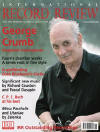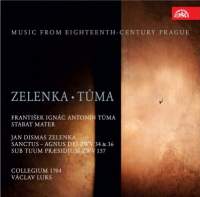Texte paru dans: / Appeared in: |
|
| "Strongly recommended." | |
|
Reviewer: Andrew
O'Connor As far as the front and back covers of this disc are concerned, the performers are Collegium 1704 and Collegiurn Vocale 1704. So it was a delightful surprise when opening the booklet to discover that singers of the eminence of soprano Hana Blaikova and bass Tomas Král, are among the performers. Blaikova, in particular, is now a major star on the Early Music circuit and her radiant voice and striking looks are not something most record companies and concert promoters are shy about ‑ particularly as Zelenka's religious music usually features glittering soprano solos. Even before one listens to the recording, however, it is clear from Vaclav Kapsa's learned booklet essay why this reticence about individual singers is appropriate. The vocal works recorded here are not your typical Baroque fare, with semi‑operatic solos and thrilling choral writing. For this the latest in Supraphon's prolific Music from Eighteenth Century Prague series (I reviewed the eleventh release only last month), the theme is works by Bohemian composers written in the antique style. Frantiek Ignác Antonin Tuma (1704‑74) and Jan Dismas Zelenka (1679‑45), like many composers of the high and late Baroque, revered the Classical counterpoint of composers such as Palestrina. and Morales. (Across the confessional divide, Bach was also a great admirer of Palestrina.) Their understanding and respect for the old techniques were underpinned by the instruction of the leading Austrian composer of the day, Johann Joseph Fux (c.1660‑1741), who composed superbly in all the modern idioms of the early eighteenth century, but was probably most famous for his understanding of counterpoint as set out in his hugely influential book Gradus ad Parnassum. Tuma and Zelenka, as well as the third composer on the disc, Johann Georg Orschler (1698‑1767/70), were all taught by Fux personally and shared his reverence for the discipline and spiritual depth of contrapuntal choral music. Fux's example resulted in new compositions written in the stile antico, such as Tuma's G minor Stabat mater (today his only moderately well known work) and Zelenka's motet settings of Sub tuum praesidium, three of which are recorded here. In some cases, the presence of the old masters was more immediate, such as in the two Mass extracts by Zelenka, which are directly based on compositions by Palestrina. These practices were not quirky antiquarianism, akin to composers today who sometimes write for ancient instruments. Throughout the seventeenth and eighteenth centuries, religious ceremonies would have as often been accompanied by plainchant (whether Gregorian or Lutheran) and semi‑modernized polyphony as by the elaborate concertato music we now regard as quintessentially Baroque. Fux‑inspired polyphony is easily distinguished from its Renaissance models, as Fux doubtless intended. Such works were conceived of not as fake antiques but as modern music written largely in accordance with ancient principles. Much of their delight comes from this mixture of Renaissance ‑style polyphony with an irrepressible Baroque sensibility that keeps breaking through ‑including the snippets of solo singing that are quickly subsumed by the surrounding counterpoint in the Zelenka motets. In Tuma's Stabat mater, hints of early Classicism can even be detected. Collegium Vocale 1704 consists here of just seven voices, which sing with discipline and flair. They blend beautifully without striving for the seamless smoothness of pure Renaissance polyphonic singing. Apart from the Trio Sonata in the middle of the recordings, the instrumental arm of Collegium Vocale is confined to bass instruments supplying the continuo in the Stabat mater and colla parte support in the Zelenka choral works, both of which it does with suitable gravitas. Of course, writing in the 'learned' style was not confined to choral music: instrumental music, particularly works written for strings, could also be used to display a composers skill in counterpoint and other revered techniques. The fugal finales of some of Mozart's and Haydn's quartets are late examples of this. Orschler's F major Sonata for two violins and basso continuo opens with a very serious movement that could have been designed to show Fux, his former teacher, that he had been paying attention. The other movements are more conventional, but delightful just the same. Collegium 1704's violinists, Helena Zemenova and Jana Chytilova, play this lovely sonata with tremendous skill and palpable affection. It makes a welcome change of mood from, the very serious compositions on either side. This is
another triumph for the Music from Eighteenth‑ Century Prague series, though
in this case perhaps slightly more for its instructional value than the more
immediate appeal of the music on earlier releases. Strongly recommended. |
|
|
|
|
|
Cliquez l'un ou l'autre
bouton pour découvrir bien d'autres critiques de CD |
|




